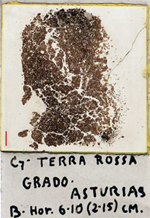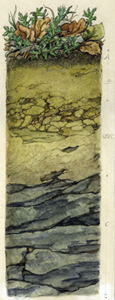This work is aimed to highlight
and publish the Collection
of Thin Sections of Soils obtained by Prof. Walter Kubiëna
during his several stays, between 1943 and 1970, in the former Institute of Pedology and Plant
Biology (Instituto
de Edafología y Biología Vegetal) of
the Spanish
National Research Council (CSIC,
Madrid). In
addition, it contributes to the celebrations of the Spanish Soil Science Society
(SECS)
related to 2015
International Year of Soils (UN Declaration A/RES/68/232).
former Institute of Pedology and Plant
Biology (Instituto
de Edafología y Biología Vegetal) of
the Spanish
National Research Council (CSIC,
Madrid). In
addition, it contributes to the celebrations of the Spanish Soil Science Society
(SECS)
related to 2015
International Year of Soils (UN Declaration A/RES/68/232).
Walter
Ludwig Konstantin
Ritter von Kubiëna
(1897-1970), born in
the former Moravia, began his studies in 1922, graduating in Soil
Science and Geology at the Hochschule für Bodenkultur in Vienna and the University of Vienna,
respectively. In 1927 he received his Ph.D. degree and in 1930 he started teaching under Prof. Dr. H. Kaserer at the Hochschule für Bodenkultur
in Vienna. In 1937 he became “ausserordentlicher Professor”
at the Department of Geology and General Soil Science and in 1941 full
professor of Geology at the same institution.
 From
the beginning Kubiëna thought that the microscope had to be
employed in the study of soils, because it is a whole, and its partial
or modified study did not allow its global knowledge [Obituary on Prof.
Kubiëna: Ángel Hoyos de Castro, Anales de
Edafología
y Agrobiología (1970) XXIX, 753-765]. This led him to
develop a
procedure for observing the soil without disturbing it, developing a
sampling technique (called Kubiena boxes) and to prepare thin sections
for its observation and study. After a stay at the University of Iowa
(USA) as a visiting professor in 1937, he published the book entitled
Micropedology,
key work and start point of the science called Soil
Micromorphology. According to Kubiena, different soil
types should have
different microstructures that would serve for their characterization.
With these ideas he began his explorations around the world to study
the soils, always accompanied by a small microscope to recognize them
in the field.
From
the beginning Kubiëna thought that the microscope had to be
employed in the study of soils, because it is a whole, and its partial
or modified study did not allow its global knowledge [Obituary on Prof.
Kubiëna: Ángel Hoyos de Castro, Anales de
Edafología
y Agrobiología (1970) XXIX, 753-765]. This led him to
develop a
procedure for observing the soil without disturbing it, developing a
sampling technique (called Kubiena boxes) and to prepare thin sections
for its observation and study. After a stay at the University of Iowa
(USA) as a visiting professor in 1937, he published the book entitled
Micropedology,
key work and start point of the science called Soil
Micromorphology. According to Kubiena, different soil
types should have
different microstructures that would serve for their characterization.
With these ideas he began his explorations around the world to study
the soils, always accompanied by a small microscope to recognize them
in the field.
As a result of his deep knowledge of soils, Kubiëna faced the
problem of their classification and thus, in 1953, wrote the book The Soils
of Europe, published
simultaneously in German (Bestimmungsbuch und Systematik der Böden Europas), English and Spanish (Claves Sistemáticas
de Suelos)
. In 1955 he became
Director of the Department
of Soil Science of the Federal Forest Research Centre
in Reinbeck (Hamburg, Germany). There he was visited by numerous
researchers from other countries to learn micromorphology, including
Altemüller (Germany), Jongerius (Netherlands), Brewer
(Australia)
and Fedoroff (France). The Spaniards Hoyos de Castro, Delgado, Paneque,
Alías and Benayas were part of the list of his
distinguished
pupils.
(France). The Spaniards Hoyos de Castro, Delgado, Paneque,
Alías and Benayas were part of the list of his
distinguished
pupils.
For
his scientific career, Kubiëna received many awards
and honors. The Alfred
Toepfer Foundation awarded him with the Justus von Liebig Prize;
he was honorary member of the CSIC and of the Soil Sciences Societies
of Austria and Germany, and Doctor "honoris causa" of the Complutense University of Madrid
(Spain) and Santa
María de Rio Grande (Brazil). The Kubiena
Medal is the only medal awarded by the International Union of Soil
Sciences (IUSS)
and is given for outstanding and sustained performance in the
discipline of soil micromorphology.
This document includes a literal transcription of the manuscript
completed in 2002 by Drs. Benayas and Martin Ramos on the work of Prof.
Kubiëna, as well as the photographs of the collection trays
made
by Mr. Antonio Jorge (2014). The greatest scientific value of the
present publication is mainly due to the cooperation of Prof. Carlos
Dorronsoro (Department
of Soil Science, Univ. of Granada), who made the navigable
macroimages and microphotographs (2014-2015).
The original thin sections of this collection are deposited in the Institute of Agricultural
Sciences (Instituto
de Ciencias Agrarias, ICA), former Institute of Pedology and Plant
Biology (Instituto
de Edafología y Biología Vegetal),
and are part of the historical heritage of the CSIC. The same institute also maintains the
original watercolor paintings made by Gertrud Kallab and Anton Prazak, included in the book The Soils
of Europe.
M. Teresa García González
Director, Institute of
Agricultural Sciences
Spanish National
Research Council
Madrid, January 2015
Additional information
for the reader
These pages are composed of a general table (accessed through the link
shown above as  Home)
containing a list of all trays and thin sections, with the same
structure of the original work sheets. The table shows several
photo-camera symbols that link to pages showing trays and thin
sections. In addition, all displayed images are linked to larger ones,
or to navigable macroimages and microphotographs. Text in remaining
pages has not been translated into English.
Home)
containing a list of all trays and thin sections, with the same
structure of the original work sheets. The table shows several
photo-camera symbols that link to pages showing trays and thin
sections. In addition, all displayed images are linked to larger ones,
or to navigable macroimages and microphotographs. Text in remaining
pages has not been translated into English.
Enjoy it!
© CSIC. The
text, data and
information in these pages are available for personal use only.
Therefore, permission of the CSIC is required for their publication,
distribution or inclusion in any context accessible to third parties (direccion.ica@csic.es).
 former Institute of Pedology and Plant
Biology (Instituto
de Edafología y Biología Vegetal) of
the Spanish
National Research Council
former Institute of Pedology and Plant
Biology (Instituto
de Edafología y Biología Vegetal) of
the Spanish
National Research Council  former Institute of Pedology and Plant
Biology (Instituto
de Edafología y Biología Vegetal) of
the Spanish
National Research Council (CSIC,
Madrid). In
addition, it contributes to the celebrations of the Spanish Soil Science Society
(SECS)
related to 2015
International Year of Soils (UN Declaration A/RES/68/232).
former Institute of Pedology and Plant
Biology (Instituto
de Edafología y Biología Vegetal) of
the Spanish
National Research Council (CSIC,
Madrid). In
addition, it contributes to the celebrations of the Spanish Soil Science Society
(SECS)
related to 2015
International Year of Soils (UN Declaration A/RES/68/232). From
the beginning Kubiëna thought that the microscope had to be
employed in the study of soils, because it is a whole, and its partial
or modified study did not allow its global knowledge [Obituary on Prof.
Kubiëna: Ángel Hoyos de Castro, Anales de
Edafología
y Agrobiología (1970) XXIX, 753-765]. This led him to
develop a
procedure for observing the soil without disturbing it, developing a
sampling technique (called Kubiena boxes) and to prepare thin sections
for its observation and study. After a stay at the University of Iowa
(USA) as a visiting professor in 1937, he published the book entitled
Micropedology,
key work and start point of the science called Soil
Micromorphology. According to Kubiena, different soil
types should have
different microstructures that would serve for their characterization.
With these ideas he began his explorations around the world to study
the soils, always accompanied by a small microscope to recognize them
in the field.
From
the beginning Kubiëna thought that the microscope had to be
employed in the study of soils, because it is a whole, and its partial
or modified study did not allow its global knowledge [Obituary on Prof.
Kubiëna: Ángel Hoyos de Castro, Anales de
Edafología
y Agrobiología (1970) XXIX, 753-765]. This led him to
develop a
procedure for observing the soil without disturbing it, developing a
sampling technique (called Kubiena boxes) and to prepare thin sections
for its observation and study. After a stay at the University of Iowa
(USA) as a visiting professor in 1937, he published the book entitled
Micropedology,
key work and start point of the science called Soil
Micromorphology. According to Kubiena, different soil
types should have
different microstructures that would serve for their characterization.
With these ideas he began his explorations around the world to study
the soils, always accompanied by a small microscope to recognize them
in the field. (France). The Spaniards Hoyos de Castro, Delgado, Paneque,
Alías and Benayas were part of the list of his
distinguished
pupils.
(France). The Spaniards Hoyos de Castro, Delgado, Paneque,
Alías and Benayas were part of the list of his
distinguished
pupils. Home)
containing a list of all trays and thin sections, with the same
structure of the original work sheets. The table shows several
photo-camera symbols that link to pages showing trays and thin
sections. In addition, all displayed images are linked to larger ones,
or to navigable macroimages and microphotographs. Text in remaining
pages has not been translated into English.
Home)
containing a list of all trays and thin sections, with the same
structure of the original work sheets. The table shows several
photo-camera symbols that link to pages showing trays and thin
sections. In addition, all displayed images are linked to larger ones,
or to navigable macroimages and microphotographs. Text in remaining
pages has not been translated into English.